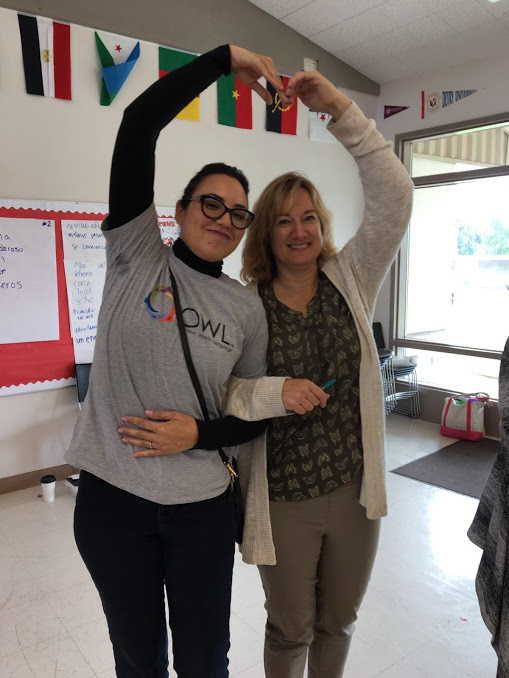
These are notes from the Organic World Language Google Meet: Collaborative Planning for Remote Instruction held on March 16, 2020. There is also an audio recording on YouTube: https://www.youtube.com/watch?v=sWs50F0W5pg&t=3s
Contact info:
Darcy Rogers info@organicworldlanguage.com
Tips for Remote Learning:
Google voice
Google Meet with the whole class and/or then small groups
Zoom
Edmodo
Flipgrid – can record videos, reply to each others videos and watch each others videos
Free app: preschool through 8th grade, create a topic that you post. Ask for a video and ask for evidence of what they have done in regards to that topic. Site has training and FAQs. Flipgrid.com
You give your students a code to log in. They do not need an account.
Students ‘present’ on vocabulary they’ve been acquiring and then students take 3 words from someone else and then create new language with it
Moodle – Collaborate. Can record videos for yourself.
Google classroom – apps related to google classroom
Uploading and assigning documents
Putting a list of resources on there.
Libraries are offering free apps and resources
Mango languages free through library
Storyjump – to communicate with other classrooms – creating stories together about personal experiences
Canvas – Big blue – video conferencing
We’ve done a project on TiKTok, it was the first time I used it
Private FB page where kids can interact
Start a class website where students can message back and forth to each other
I often use EdPuzzle for videos.- can search youtube via edpuzzle. can take a video from youtube, etc.
Can stop at any point and add voice, comprehension questions, etc.
You can use Screencast-o-matic to record your voice on top of those short animated films that don’t already have audio recorded
I use padlet for class discussions – post a question and all the kids respond to it. Links up nicely with google classroom. Different formats and different questions, kind of like having sticky notes.
Seesaw – another platform. Not as interactive as flipgrid. Are different features. Can draw and record their voice on top of it. Can take a picture, draw/write and record their voice on top of it. Also just a regular video platform.
The cardboard app is a way of making your iphone a virtual reality goggles.
A fun way to experience many different locations: https://arvr.google.com/cardboard/apps/
Organic Content:
What topics are relevant to your students?
Corona
Home life
What wearing
How are you breaking up your day? How it is different than a regular school day? Do you prefer online learning or in school? why?
How many siblings do you have? Are you interacting with them more than usual? Tell me something special about your siblings.
popular tv shows to watch right now
Topic: ways to relieve anxiety
I love the idea of keeping in mind that the kids are already dealing with anxiety. Let them grow… let them be..
Important to address equity – especially when talking about home or family
I have a friend that has been doing distance learning for almost a month now. She is taking her travel experiences and photos and turning them into Google Slideshows with photos and captions. Cool way to show off all of those authentic artifacts you have from traveling and you could use them as prompts for students to comment or share their own.
Once a week check in per class
How to gather an ‘organic road map’?
Google doc – as each group meets, teacher is recording language that happens as they’re meeting
Google doc – put it on through the google classroom – also a google doc thats open to anyone.
Students do own list and then share out – cross compare and act out
Consider meeting in small groups. 1:1 was really time consuming. After spring break our topic will be what they did.
*Sharing our own personal communications and interactions
Be motivated! Motivate yourself! Like a BINGO game – students choose a number of items from a board. Could also be a list. You can decide how they are accountable: share out to another student, share out in a large group, share out in small groups, share out in a written platform such as edmoto, a classroom web page, etc. Below are some ideas – all in the target language. This is just a start, really anything that can is cultural and in the target language is great!
Listen to songs/music
Read a book in TL
Read short stories
Read poems
Read articles
Watch newscasts
Movies
Short films
Cartoons
Commercials
Infographics
Art
Dance
Etc….
Light up the brain–gestures+words activate cognition
Does anyone have tips for asynchronous lessons?
Using one of the platforms above for students to be able to interact, recording and watching videos, spaces where they can type/interact/draw and respond later
Assign partners and give plenty of time (e.g. 48 hours) until the task needs to be submitted
General ideas:
Google tours of a museum
Sharing something that students have learned
Short Films: Before the crisis, I had been showing the short videos about insects and bugs called “MInuscule.” The plots are very simple. Today, the video showed a centipede and a snail crossing a highway. I was able to elicit statements like, “The centipede is afraid to cross the road.” “The snail helps the centipede: https://www.youtube.com/watch?v=F22jHHpIZ4A&t=17s
Short Animated Films that I’ve used with Spanish 1 and 2s: Tamara, Kitbull, Feast (pixar), One Small Step, Hair Love (uses English audio),
Assigned pairs or small groups
Notes:
Show and tell – introduced pets, photographs, pictures
Talk about where they are
Give a list of what to do – students appreciate the straightforwardness
Ideas for how to handle equity when students do not have Internet access at home or nearby?
Many students do have access to phones. Incorporating apps or ways of communication, activities that can be done on a phone. This can include, but is not limited to using pictures they already have, looking up pictures, links, google voice, zoom, google meet, etc.
Authentic Resources Ideas and links:
Call on your own personal friendships, family and connections in other countries, especially ones from the language you teach. Ask them to send memes, videos and jokes about being home or other related issues to share with students
For #authres you can search hashtags in TL on social medias
google arts and culture
Pictures
Memes
Using what they have in the house
Webcam
Infographic
Frida Kahlo house in Mexico & in Madrid, Spain
Articles
Magazines
Newscasts
Images – websites that have images
Cardboard app
Google earth
El corte ingles
AJ+ español
https://www.grahnforlang.com/authentic-resources.html – Great link for authentic resources
Virtual reality links
All authentic photos specific to languages and cultures all over the world
Here is also a google folder with authentic commercials
https://drive.google.com/open?id=0B5_9AZ_yvokxZnB6MFdsUWhPQ2s
Assessment:
Some schools are not assessing in the typical way – more about the content and engaging them as much as possible
Diverse home situations – be sensitive to equity issues
Think about our traditional thoughts about assessment – show growth in other ways
Exit slip – at end of day asking open-ended questions or pictures and students use the language they have to discuss / write about it
Create google sign up sheet – students meeting individually (10 min for example) once a week
Still able to show language growth
Summative assessment: ask open-ended (to talk or write about) where students respond with the language they have been using / seeing / etc.
Put together a choice board for them, give them a week or so to do 10-15 tasks, then do one-on-one interviews to ask them about what they watched/saw/did/read/listened to etc then they would be held accountable for actually doing it while I am still assessing their proficiency
Language specific links:
Not all appropriate but good netflix list: https://remezcla.com/lists/film/latino-movies-stream-netflix-news-break-2020/
Unesco Biblioteca Digital Mundial https://www.wdl.org/es/
1jour1actu – for French
AlanxElMundo is a great authentic resource for Spanish. He’s mexican, but he travels everywhere from Anne Frank’s House to Taiwan. He gives travel tips and gives a lot of historical background. It is closed captioned in Spanish (I’d recommend for classes Spanish 2 and up)
Eli Language Magazine (by different proficiency levels); Peppa Pig; Extr@; Fabuloso Vocabulario
I love “De Mi Rancho a tu Cocina” on Youtube. https://www.youtube.com/channel/UCJjyyWFwUIOfKhb35WgCqVg
General links:
Here is also a google folder with authentic commercials
https://drive.google.com/open?id=0B5_9AZ_yvokxZnB6MFdsUWhPQ2s
Virtual Field Trips: https://chesapeakefamily.com/fun/fun-stuff-to-do/9901-virtual-field-trips-kids-can-explore-the-world-from-home?fbclid=IwAR3JJjd4OM9fMlak60juVGYEDrNTbR5wcSjX7WuaUhamR9PC7PsYMDT_Zn0
National Parks:
Other Virtual Field Trips:
Museum Tours:
Links:
Lets kids play instruments online. Instruments include the guitar, piano, pan flute, drums, and bongos. https://www.virtualmusicalinstruments.com/
The San Diego Zoo has a website just for kids with amazing videos, activities, and games. Enjoy the tour! https://kids.sandiegozoo.org/
Tour Yellowstone National Park!
https://www.nps.gov/…/lea…/photosmultimedia/virtualtours.htm
Travel to Paris, France to see amazing works of art at The Louvre with this virtual field trip.
https://www.louvre.fr/en/visites-en-ligne
This Virtual Tour of the Great Wall of China is beautiful and makes history come to life.
https://www.thechinaguide.com/destinati…/great-wall-of-china
This iconic museum located in the heart of London allows virtual visitors to tour the Great Court and discover the ancient Rosetta Stone and Egyptian mummies. https://britishmuseum.withgoogle.com/
Resources for Spanish practice
https://www.difusion.com/campus/
Chinese learning activities
Music is for everyone
https://musiclab.chromeexperiments.com/Experiments
Movement and mindfulness videos created by child development experts
Kid-friendly workouts — choose from Strength for Kids, Agility for Kids, Flexibility and Balance for Kids, Warm-Up for Kids, Cooldown for Kids, Stand Up and Move for Kids, OR create your own custom kid workout. https://app.sworkit.com/collections/kids-workouts
Randomly generates 356,300,262,144 story starters
Allows students to type in any city, state, or country to view an archive of historical photographs and other documents. It’s a unique way to help them learn about history.
No need to travel to one of the Smithsonian’s zoos or museums — this website brings your child everything from live video of the National Zoo to the Smithsonian Learning Lab right to their screen https://www.si.edu/kids
Alaskan Wildlife cams
http://www.adfg.alaska.gov/index.cfm?adfg=viewing.webcams
